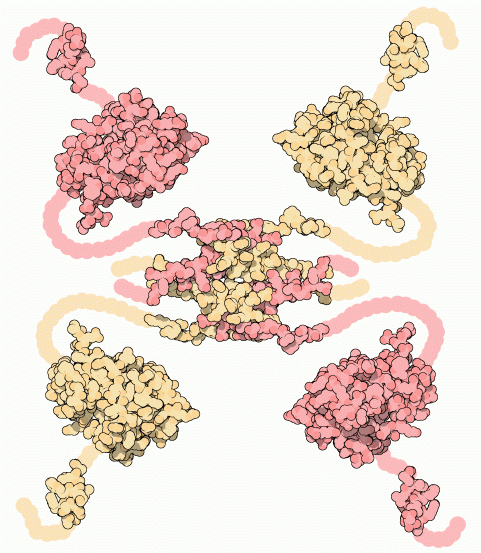|
Inhaltsübersicht | Nanomaschinen | Moleküle | Programme | Kurse | Fun | Links |
||
| > |
p53 Tumor Suppressor

Guardian of the Cell
Our cells face many dangers, including chemicals, viruses, and ionizing radiation. If cells are damaged in sensitive places by these attackers, the effects can be disastrous. For instance, if key regulatory elements are damaged, the normal controls on cell growth may be blocked and the cell will rapidly multiply and grow into a tumor. p53 tumor suppressor is one of our defenses against this type of damage. p53 tumor suppressor is normally found at low levels, but when DNA damage is sensed, p53 levels rise and initiate protective measures. p53 binds to many regulatory sites in the genome and begins production of proteins that halt cell division until the damage is repaired. Or, if the damage is too severe, p53 initiates the process of programmed cell death, or apoptosis, which directs the cell to commit suicide, permanently removing the damage.Structures by Parts
p53 tumor suppressor is a flexible molecule composed of four identical protein chains. Flexible molecules are difficult to study by x-ray crystallography because they do not form orderly crystals, and if they do crystallize, the experimental images are often blurry. So, p53 has been studied in parts, by removing the flexible regions and solving structures of the pieces that form stable structures. Three of these compact, globular portions, termed "domains", have been studied. At the center of p53 is a tetramerization domain (PDB entry 1olg) that ties the four chains together. A long flexible region in each chain then connects to the second stable domain: a large DNA-binding domain (PDB entry 1tup) that is rich in arginine residues that interact with DNA. This domain recognizes specific regulatory sites on the DNA. The third stable domain studied thus far is the transactivation domain (PDB entry 1ycq), found near the end of each arm, that activates the DNA-reading machinery.p53 and Cancer
As you might guess from its name, p53 tumor suppressor plays a central role in the protection of your body from cancer. Cancer cells typically contain two types of mutations: mutations that cause uncontrolled growth and multiplication of cells, and other mutations that block the normal defenses that protect against unnatural growth. p53 is in this second category and mutations in the p53 gene contribute to about half of the cases of human cancer. Most of these are missense mutations, changing the information in the DNA at one position and causing the cell to build p53 with an error, swapping an incorrect amino acid at one point in the protein chain. In these mutants, the normal function of p53 is blocked and the protein is unable to stop multiplication in the damaged cell. If the cell has other mutations that cause uncontrolled growth, the cell will develop into a tumor.Next: Embracing DNA
Last changed by: A.Honegger,